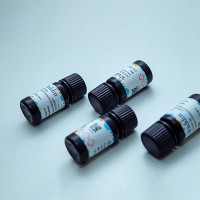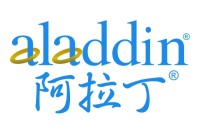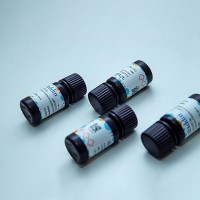Enzyme-Linked ImmunoSorbent Assay (ELISA) for NGF
互联网
A. DAY 1 PROCEDURE
• ABSORPTION OF THE POLYCLONAL AND PREIMMUNE SERUM
The Goat Anti-Mouse (GAM) NGF polyclonal antibody recognizes 2.5B NGF and the Goat IgG (GIG) preimmune serum serves as a control for the antibody (Hazleton). The relative signal of a standard or sample is calculated by subtracting the GIG value from the GAM value for each sample. Add 8.6 µl of (GIG, 77 mg/ml) and 10.0 µl (GAM, 66 mg/ml) to two separate tubes containing 10 ml COATING BUFFER. To a 96 well plate (Nunc), multipipet 100 µl/well of GIG into alternating rows (A, C, E, G) and GAM into the remaining rows (B, D, F, H). In this step, and following incubations, place a thin strip of parafilm over the groove where the lid and bottom of plate meet to prevent evaporation of solutions. Incubate plates on a rotator (4-8 rpm) at 4°C overnight.
B. DAY 2 PROCEDURE
• BLOCKING
Block the plates by applying 200 µl/well BLOCKING BUFFER to the freshly washed plates. Incubate at 4°C for a minimum of 1 hour. In this step and all additional washing steps, first remove the present solution with a pasteur pipet attached to a vacuum. Aspirate all GIG (A,C,E,G) then all GAM (B,D,F,H) rows, changing the pipet to avoid contamination. Then, fill each row to the top with the WASHING BUFFER using the Nunc washing apparatus. Aspirate with pasteur pipets as before. A triple wash is required, this time using the Nunc washer to fill and aspirate each row 3x simultaneously before moving on to the next row. Dry the wells by removing the remaining liquid with pasteur pipets as described previously, but do not leave dried wells for an extended period of time.
• SAMPLE PREPARATION
A volume of 400 µl per sample is the minimum amount needed to obtain duplicate values (100 µl per well for 2 GIG and 2 GAM wells). 0.1% Tween is added to the SAMPLE BUFFER to increase the amount of NGF removed from the sample. Typically, a 10x dilution (w/v) of tissue samples will give a signal sufficient for detection. Once diluted, samples are homogenized on ice for 30 seconds using a cell sonicator at micro tip limit. Wash the tip between samples with distilled water. Centrifuge for 30 minutes at 15,000 G Force under refrigeration.
• PREPARATION OF NGF STANDARDS
When preparing these standards, mix gently, the NGF is fragile and over mixing by vortexing can destroy the protein. Use 25 µl of 0.41 mg/ml NGF
| Tube # | NGF | 0.05% Acetic Acid | Final Conc. |
|---|---|---|---|
| 1 | 25 µl | 975 µl | 10 µg/ml |
| 2 | 100 µl #1 | 9.9 ml | 100 ng/ml |
| 2.5 | 100 µl #2 | 900 µl | 10 ng/ml |
| 3 | 100 µl #2 | 9.9 ml | 1 ng/ml |
Use the above solutions to make the following more dilute standards
| Pg NGF/100 µl | Add | Sample Buffer +0.1%tw |
|---|---|---|
| 100 | 30 µl of #2 | 3 ml |
| 50 | 15 µl of #2 | 3 ml |
| 25 | 75 µl of #2.5 | 3 ml |
| 12.5 | 37.5 µl of #2.5 | 3 ml |
| 6.25 | 18.75 µl of #2.5 | 3 ml |
| 3.12 | 93.6 µl of #3 | 3 ml |
| 1.56 | 46.8 µl of #3 | 3 ml |
• PROTEIN RECOVERY
Is determined by adding a known amount of NGF (spiking) to an adjacent aliquot of the sample being measured. The percentage recovery of NGF can then be determined by subtracting the pg of NGF per well of the sample from that of the spiked sample and then dividing by the added amount. A common spiking amount is 25 pg per well or 100 µl sample (2.5 µl of tube 2.5 to each 100 µl of sample).
• DESIGNING THE PLATE
To account for inter-plate variations, a complete set of standards should be included on each plate. To account for intra-plate variation, the standards should be alternated from top to bottom and from left to right within the plate. A common plate design will contain the 100 pg/well standard in the top left corner and the bottom left corner (A1, B1, G1, H1), the 50 pg/well standard in the top right and bottom right corner (A12, B12, G12, H12), the 25 pg/well standard next to the 100 pg standard (A2, B2, G2, H2), and the 12.5 pg/well standard next to the 50 pg standard (A11, B11, G11, H11). The lower concentrations are run in quadruplicate since more values fall into this range. The 6.25 pg/well standard placed in wells A3 through H3, the 3.12 pg/well standard in wells A10 through H10, the 1.56 pg/well standard in wells A4 through H4, and the blank or sample buffer (0 pg/well) in wells A7 through H7. The 12 samples are placed in the remaining 4-well pockets consisting of 2 GIG wells and 2 GAM wells.
• APPLYING THE STANDARDS AND SAMPLES
Add 100 µl/well of each solution and incubate at 4°C on the rotator overnight.
C. DAY 3 PROCEDURE
• APPLYING THE MONOCLONAL
Single wash, then triple wash the plates as described previously with special attention to the aspiration step. Maintaining the GIG then GAM sequence, aspirate the standards from low concentration (blank) to high concentration (100 pg). In this way, only 2 pipets are needed for the standards. Using a new pipet for each sample (12 pipets total), aspirate by removing solution from both GIG wells then the GAM wells. Once the plate has been washed, multipipet 100 µl/well (1:200) monoclonal anti-NGF antibody (Hazleton) prepared by adding 100 µl IG3 (2.42 mg/ml) to 20 ml blocking buffer with the addition of 200 µl of 10% Tween. Incubate the plates at 4°C on the rotator overnight.
D. DAY 4 PROCEDURE
• APPLYING SECONDARY ANTIBODY
To a freshly washed plate, apply 100 µl/well of 1:625 Biotinylated Goat anti-rat IgG prepared by adding 32 µl IgG (Calbiochem #60653) to 20 ml blocking buffer with the addition of 200 µl of 10% Tween. Return plate to the 4°C on the rotator for 6 hours.
• APPLYING STREPTAVIDIN
After 6 hours, add 100 µl/well of 1:2000 streptavidin solution prepared by adding 10 µl peroxidase conjugated streptavidin (Zymed #43-4323) to 20 ml blocking buffer. Incubate for 1 hour at room temperature on a rotator.
• CHROMAGEN DEVELOPMENT
10 min before washing the plates, add a 10 mg OPD (Sigma #P8287) tablet to 25 ml SUBSTRATE BUFFER and store tube in a dark drawer. Immediately before applying the chromagen to the plate, add 10 µl of 30% H2O2 to the substrate buffer-OPD solution. Mix well and add 100 µl to each well as quickly as possible. Incubate plate for 10 minutes on the room temperature rotator under a light proof object, such as an ice bucket lid. Store the remaining solution in a dark drawer to use on the second plate.
• READING THE PLATE
Read the plate using a 492 nm wavelength in the plate reader (Bio Rad model 2550) interfaced with a Macintosh computer running MacReader 2.0 software. Before reading the plate, blank the reader by advancing to a column on a separate plate to which 100 µl substrate buffer and 50 µl of 2.5M Sulfuric Acid has been added. When the 10 minutes are up, add 50 µl/well of 2.5M Sulfuric Acid to stop the reaction and immediately read the plate. The colored end-product should be more stable and can be stored at 4°C for extended storage.
SOLUTIONS
PBS SOLUTION, 50 mM
Sodium Phosphate, Monobasic 1.50 g
Sodium Phosphate, Dibasic 6.53 g
Sodium Chloride 116.38 g
Distilled H2O up to 1.0 liter
PBS SOLUTION,10 mM, pH=7.4
50 mM PBS 1 liters
Distilled H2O 4 liters
COATING BUFFER pH=9.6
Sodium Azide .2 g
Sodium Bicarbonate 2.93 g
Sodium Carbonate 1.71 g
Distilled H2O up to 1 liter
WASHING BUFFER
10% Tween 20 ml
10 mM PBS 4 liters
BLOCKING BUFFER
10 mM PBS 99 ml
FCS 1 ml
SAMPLE BUFFER
0.5% BSA (Albumin Bovine) 2.5 g
.0001% or 1 µg/ml Aprotinin .0005 g
0.1 mM Benzethonium Chloride .022 g
0.1 mM PMSF (Phenylmethyl Sulfonyl Fluoride) .0086 g dissovled in 400 µl 95% ethanol
10 mM PBS up to 500 ml
ACETIC ACID, 0.05%
Glacial Acetic Acid .5 ml
Distilled H2O 1 liter
SUBSTRATE BUFFER, pH=5.0
Sodium Phosphate, dibasic 25.7 ml (2.84 g/100 ml=.2 M)
Citric Acid 24.3 ml (1.92 g/100 ml=.1M)
Distilled H2O up to 100 ml
SULFURIC ACID, 2.5 M
Sulfuric Acid 137.5 ml
Distilled H2O up to 1000 ml
REAGENTS
| Chemical | Catalogue # | Vendor |
|---|---|---|
| NaH2PO4 (Anh.) | S-0751 | Sigma |
| NaCl | S-9625 | Sigma |
| BSA | A-7888 | Sigma |
| Aprotinin | A-1153 | Sigma |
| PMSF | P-7626 | Sigma |
| Benzethonium Chloride | B-8879 | Sigma |
| 10% Tween | 28320 | Pierce |
| NaN3 | S-2002 | Sigma |
| NaHCO3 | S-8875 | Sigma |
| Na2CO3 | S-2127 | Sigma |
| FCS | F-4884 | Sigma |
| Na2HPO4 | S-0876 | Sigma |
| Citric Acid | C-0759 | Sigma |
| H2O2 | H-1009 | Sigma |
| OPD | P-8287 | Sigma |
| Streptavidin | 43-4323 | Zymed |
| Biotinylated Goat Anti-rat IgG | 60653 | Calbiochem |
Reference
Weskamp, G., and Otten, U. (1987). An enzyme-linked immunoassay for nerve growth factor (NGF): A tool for studying regulatory mechanisms involved in ngf production in brain and in peripheral tissues. Journal of Neurochemistry, 48 (6),1779-1786.







